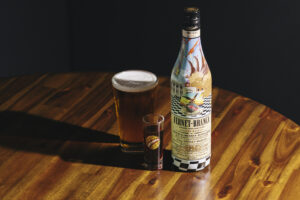A Fresh Look At Fernet-Branca, Your Favorite Bartender’s Favorite Amaro
This article is a part of “A Fresh Look,” a series exploring the evolution of beloved alcohol brands throughout history. Whether it be a centuries-old amaro or a hotshot tequila brand with a chip on its shoulder, liquor brands have a way of ebbing and flowing with drinking trends of the day. In this series, The Daily Pour investigates the origins of these boozy institutions, if and how they’ve changed recipes over the years and the ways that marketing, culture and mixology have embedded them in the hearts of consumers.

Fernet-Branca’s 180th anniversary bottle. (Photos: Fernet-Branca)
Fernet-Branca doesn’t give a damn about its bad reputation.
National Geographic once called the amaro “a massive cloud of dust with assorted fists, feet emerging from it at various angles.” Vice added a hint of poetry to the description, saying that the infamous liqueur tastes like “a synesthetic explosion of ‘brown’ that finds its way into the furthest reaches of the nasal cavity and spreads to the darkest recesses of the cranium.” CNN simply wrote: “Think medicine tastes awful? Maybe Fernet isn’t the drink for you.”
These are a small handful of the countless less-than-glowing things said of Fernet-Branca, invented in 1845 by self-taught herbalist Bernardino Branca. Like many centuries-old Italian amari, the exact recipe is a closely guarded secret. The brand has only gone so far as to drop a breadcrumb trail, confirming the inclusion of myrrh, saffron, cinnamon, Thai ginger, linden, chamomile and rhubarb. If that sounds like the beginnings of a house-made cough syrup, then you’re beginning to grasp the point. In fact, Fernet was originally conceived as an over-the-counter cure for cholera and menstrual pain.
Thankfully, the amaro found its way from hokey doctors to aficionado bartenders.
The year is 2025, and Fernet-Branca commands a totemic presence within the international mixology world. Some serve it as a shot, others with espresso; others still mix it into root beer, tonic water or, the most popular of all, Coca-Cola. The amaro is so beloved in the bartending world that it has its own secret society. Collectible Fernet coins — first introduced in 2012 — are a keepsake among discerning fans, slammed down on the counter with a knowing wink in exchange for a free shot of the good stuff.
We sat down with Edoardo Branca, the sixth-generation scion to the Fernet-Branca empire, to learn more about the past, present and future of an amaro clouded in mystique and cult-like dedication.
How Fernet Conquered the Market, One Soaring Eagle at a Time

Most mixologists cite San Francisco as the birthplace of all things Fernet-Branca in the United States. The statistics back that up. Thirty-five percent of Fernet-Branca imported to the U.S. is reportedly consumed in the Golden City, where the liqueur has a homespun cult appeal similar to Malört‘s stranglehold over Chicago. Much too like Malört, Fernet-Branca wields a potent, borderline uninviting edge, dripping with pitch-black licorice and spearmint notes that taste like a sort of booze-soaked menthol cigarette. A flavor better passed around by word of mouth than a Super Bowl ad spot.
If ever there was a counter-cultural liqueur, it would be Fernet-Branca. And what better city to deliver on that promise?
“You know, people always ask why San Francisco drinks more Fernet than anywhere else. The truth is, it didn’t happen by accident,” Branca says. “Years ago, we had an incredible sales rep, Steph, who basically became our ambassador before that was even a title. She was everywhere in the city — from cocktail bars to little corner dives — making sure Fernet was in people’s hands… And if San Francisco can make Fernet-Branca its drink, then so can any city.”
According to Branca, Steph pitched Fernet-Branca to bartenders as “a bong in a bottle.” The phrase stuck. By the late 1990s, the Italian amaro was charting record sales in California, paving the way for a nationwide winning streak that has persisted to this day.
It’s a neat origin story. But the lore only captures the beginnings of the American Fernet craze. Ask your local barkeep, and you’re likely to get a wildly different telling of events on how the liqueur arrived in Miami, Austin, Philadelphia or beyond.
Dan Stern, head bartender at New York City’s Bandits Burger + Dive, offers his own twist. Stern claims that his manager at a previous bar forbade staff from drinking any alcohol behind the counter — except Fernet. The idea being that the amaro was so unappetizing, so repulsive, that bartenders would have to remain sober throughout their shift. Of course, that’s not what happened. Stern now considers himself a Fernet convert, pouring up shots at his West Village bar to of-age NYU students and otherwise trendy locals. Fans of the amaro often joke that it has a “so bad, it’s good” appeal; in this case, and perhaps many others, it quite literally did.
And then there’s Argentina. Though Fernet may have been born and raised in the landlocked city of Milan, Italy, it was the shores of South America that ultimately proved to be the amaro’s enduring home base.
Argentina reportedly consumes over 75% of the world’s Fernet supply, equivalent to roughly 19 million liters per year. So popular is Fernet in Argentina that the liqueur’s only production facility located outside of Italy is based in the Parque Patricios neighborhood of Buenos Aires.
Unlike San Francisco, however, the origin story contained therein is infamously murky. Fernet was introduced to the country during the Great Immigration Wave of the late 19th and early 20th centuries, when some 2.9 million Italians arrived in Argentina over the span of a mere six decades. (Fun fact: Over 60% of Argentinians can trace their lineage back to Italy.) Through some combination of savvy marketing, local scuttlebutt and creative mixology, Fernet emerged as a force to be reckoned with. Fernet Con Coca — an easygoing highball that’s two parts Coca-Cola, one part Fernet-Branca — is now the official cocktail of Argentina. In 2020, it became the first Argentine drink officially recognized by the International Bartenders Association.
Cultural critic Diego Vecino described the amaro in mythological proportions, dubbing Fernet an “anecdote in the folds of Argentina’s early modernity.” He wrote:
“It can perfectly function as a metaphor for Argentina’s first great process of social, political, and cultural modernization, around the first decade of the 20th century, when the most massive immigration in the country’s history brought two things to our land, among many others: anarchism and Branca.”
Though Vecino may have only been touching on one time and one place, his words capture the gist of what Fernet-Branca has undergone the world over. For whatever reason, the Italian amaro has been able to embed itself in cultures thousands of miles apart, picking up a new tidbit of local lore and preferred drinking ritual at every new city along the way.
So where, you may ask, are the great Fernet hotspots outside of San Francisco and Argentina? We figured we’d ask Branca.
“In Europe, Fernet is most often enjoyed as a digestif after dinner, though sometimes just a small sip as an aperitif to open the stomach and spark the appetite,” Branca said. “I also remember when I was in Denmark visiting the market — they were pouring Fernet shots in the morning. Maybe it was just because I was there, but it made me smile. The Danes are known for their polar swimming, so I imagined Fernet giving them a little extra courage before diving into the ice.”
In Germany, the amaro has gained popularity by way of Fernet-Branca and Red Bull (yuck). Canadians have their own claim to fame through the Toronto, an Old Fashioned riff that combines rye whisky, Fernet, sugar and Angostura bitters (yum!). Elsewhere, Fernet has been used in remixes of the carajillo, a classic coffee cocktail originated in Spain, and the Hanky Panky, a combination of gin, sweet vermouth and Fernet invented by Sir Charles Hawtrey of London’s Savoy Hotel.
The possibilities are limitless. As too are the aged vintages.
Since Fernet tends to be talked about as a “bartender’s handshake,” it’s easy to forget that the amaro has a separate appeal in the collector’s world. Bottles dating back to the 1940s can demand prices as high as $400. The labels, worn to yellowish shreds from decades of decomposition. Though the recipe has purportedly remained the same over the years, certain vintages are bottled at higher alcohol contents, making them all the more desirable to Fernet experts in the know.
“The old labels, the weight of history in the glass — there’s something truly unique about them. And of course, the scarcity only makes collectors more eager to seek them out,” Branca says. “When it comes to flavor, it really depends on how the bottle has been stored over the years. If kept well, the rhubarb tends to intensify, the alcohol shows a little more presence, and the saffron comes forward. You’ll also notice subtle notes of myrrh rising, while the mint gently fades. Opening a vintage Fernet is always a rare and special moment—same secret recipe, but an entirely new expression to discover.”
We were fortunate enough to sample a collection of antique Fernet alongside Branca in honor of the brand’s 180th anniversary. The oldest vintage was dated to 1984. In hindsight, we couldn’t have asked for a more fitting year, as the Fernet we tried was every bit as dark and brooding as the dystopian novel of the same name.
The palate kicked off with a smack of dusty oak unlike anything found in a modern bottling. Think dry basements and drier lumber. In place of mint, chamomile was by far the most dominant flavor, soaking into the finish with a tea-like medicinality that lingered long after the first sip. Feel it on the gums; feel it on the throat. Looking around the room, it was surprising to see that everyone’s tongues hadn’t gone midnight black.
If 2025 Fernet is counter-cultural, then 1984 Fernet is downright evil. Didn’t stop us from asking for another glass.
Follow The Daily Pour:
About The Daily Pour
Founded by Dan Abrams, The Daily Pour is the ultimate drinking guide for the modern consumer, covering spirits, non-alcoholic and hemp beverages. With its unique combination of cross-category coverage and signature rating system that aggregates reviews from trusted critics across the internet, The Daily Pour sets the standard as the leading authority in helping consumers discover, compare and enjoy the best of today's evolving drinks landscape.
